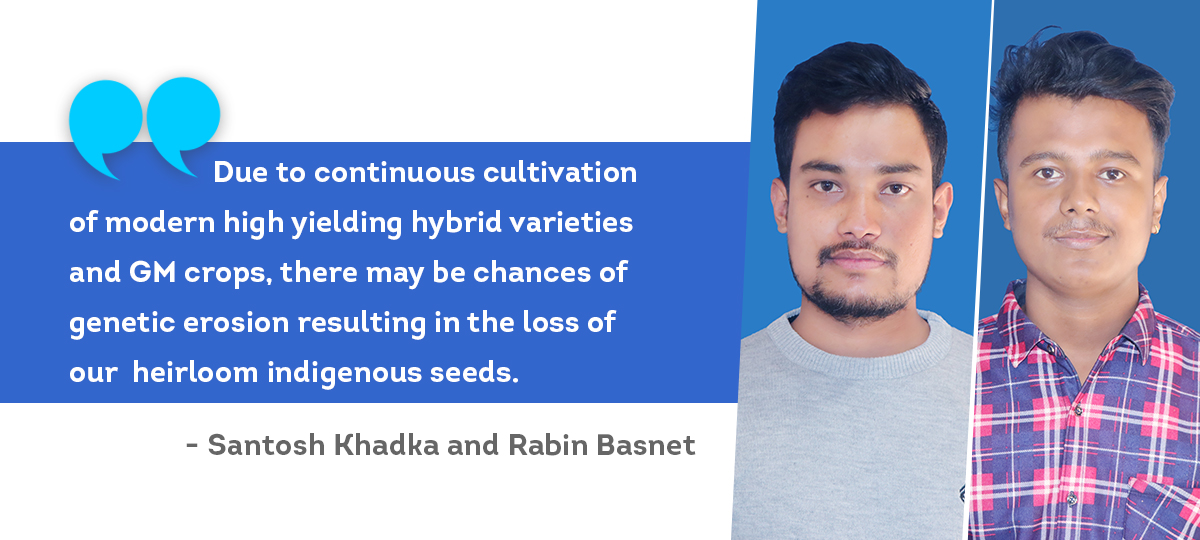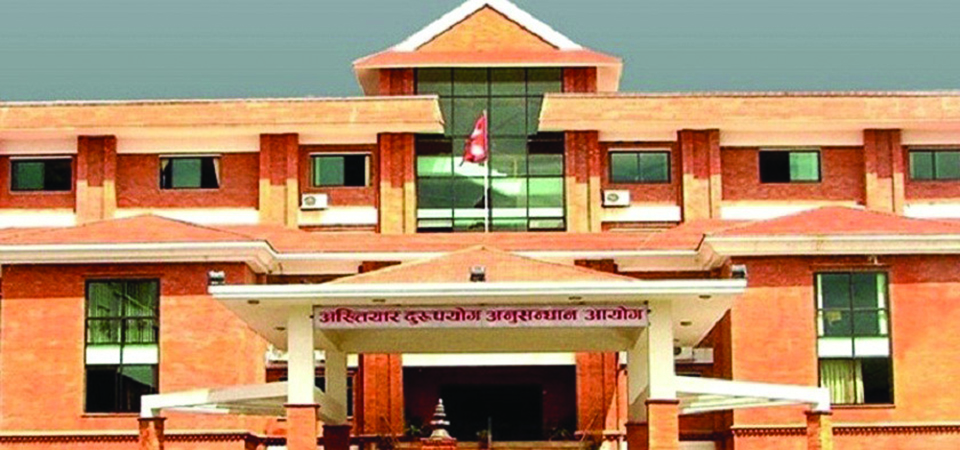
OR
Opinion:
Genetically Engineered Crops: Boon or Bane
Published On: July 17, 2021 01:46 PM NPT By: Santosh Khadka and Rabin Basnet


Santosh Khadka and Rabin Basnet
(The authors are students of MSc (Agriculture), Faculty of Agriculture, Agriculture and Forestry University, Rampur, Chitwan.)news@myrepublica.com
More from Author
Due to continuous cultivation of modern high yielding hybrid varieties and GM crops, there may be chances of genetic erosion resulting in the loss of our heirloom indigenous seeds. This may have a negative effect more on countries like Nepal where people practice informal seed systems that mainly depend upon the seeds produced on their own farms from the previous year.
The world’s population is continuously increasing and is expected to reach 10.9 billion in 2100 AD. Food production is constrained by the shrinkage of arable land, poor seed quality, pest attack, post-harvest loss, and degrading environment, amplifying the food price volatility and potentially pushing millions of people into poverty. The changing weather patterns and diversification of diets have also demanded quality and sustainable production in agriculture. In the present scenario, for increasing productivity, we are adopting different agronomic research findings, like high yielding varieties, excessive fertilizers, and managing cropping systems and patterns. Similarly, for controlling the pest, haphazard use of pesticides is also practiced. However, there is a significant gap between attainable yield and the farmers’ yield, which is challenging to feed the increasing global population.
The cultivation of hybrid and genetically-modified crops can be a better way to overcome these constraints. Hybrid crops are the offspring of two different varieties, which are cross-pollinated and constitute best traits of both parents. Pollination is carefully controlled during the development of hybrids to gain the desired combination of characters from both parents. These hybrid crops benefit by increasing the yield, improving quality, reducing the seed rates, and resistance to plant stress. The use of hybrid seeds alone can contribute 15-25% rise in crop yield.
The genetically modified (GM) crops are made by inserting the genes of one plant into another by using biotechnological techniques. Such plants may be of the same or different species, or a completely unrelated kind of organism like bacteria or animals. The aim is to introduce new traits to the plant that do not occur naturally in those species. These crops are insect resistant, herbicide resistant, and stress tolerant, which ultimately increases the crop yield by minimizing the cost of cultivation and the use of pesticides. The genes that add nutrient quality can also be introduced in the crops.
Worlds’ status of GM crops
In 1983, the first genetically modified plant, tobacco resistant to antibiotics, was made but later in 1996, delayed ripening tomato variety was commercially released. According to the International Service for the Acquisition of Agri-biotech Application (ISAAA) 2018, the area of production was 191.7 million hectares which increased from 1.7 million hectares in 1996, indicating the fastest adopted technology in the history of agriculture. Till 2018, 17 million farmers of 26 countries were cultivating genetically modified crops.
Different researchers have found the success of GM crops. The GM crop golden rice is the best example of modern biotechnology. It is a feasible and cost effective means of providing the micronutrients to populations that have limited access to diverse diets and other micronutrient intervention. In golden rice Beta- carotene, a precursor of Vitamin A was introduced. Cereals are deficient in lysine and threonine amino acids, genes producing these amino acids are introduced, which increases the nutritional character. Transgenic Bt. Corn, which produces its own insecticide, contains a gene from bacterium (Bacillus thuringiensis), saves corn from borer insects. The use of pesticides were minimized, resulting in an increase in yield while protecting the environment from its adverse effects. Photosynthetic capacity of the C3 crops, like rice, can be boosted by installing the C4 photosynthetic pathway. This has drastically increased the yield. Transgenic crops, like soybean, have high edible oil and low cyanogenic glycosides in cassava. Moreover, herbicide tolerant and insect resistant cotton, Colorado beetle resistant, potato-Y virus resistant potato varieties are also developed by this technique.
GM crops in Nepal and its consequences
In Nepal, for the first time, multinational seed company Monsanto of USA had introduced the GMO seed to fulfil the objective of their pilot program but no GM seed is registered and released in Nepal till now. All the plans and policies, like, Agriculture Perspective Plan (2052-2072 B.S.), National Agro-biodiversity Policy (2063 B.S.), Agriculture Development Strategy(2015 A.D), National Agricultural Policy (2061 B.S.), National Seed Policy (2056 B.S.) etc have strictly prohibited the use of GM seeds in Nepal, except for the purpose of research. However, research can be done only with the permission from the authorized agency but the government can ban import and research on any GMOs only with potential risk to alter diversity and negative impact on health and environment.
Nepal’s law has banned the GM crops, but the major agriculture trade of our country is linked with India, China, Bangladesh, and Pakistan, through open borders between Nepal and India, via road, where GM crops are cultivated in thousands of hectares. Unknowingly, genetically modified food is being imported from these countries. So, the testing of GM crop import, through open borders, must be made strict to control illegal entry.
In the debate of GM crops, not only the importance, but also some consequences are reported. The most debated consequence is the effect on the environment and human health. It may cause allergies to humans. However, different research papers have indicated that GM crops did not demonstrate any health risk and posited little evidence of environmental damage.
In contrast, genetic diversity is an equally important resource for food production. Due to continuous cultivation of modern high yielding hybrid varieties and GM crops, there may be chances of genetic erosion resulting in the loss of our heirloom indigenous seeds. This may have a negative effect more on countries like Nepal where we practice an informal seed system that mainly depends upon the seed produced on our own farm from the previous year. The cost of GM seed is high, which creates an economic burden on our marginalized farmers. The dependency of our seed sector will increase on foreign countries, which may lead to non-availability of planting material at the right time and place.
Everything has pros and cons. Nepal is in the infant stage of GM crop cultivation. Instead of direct legalization, increasing research will be helpful for marking and nullifying the negative impacts. Then cultivation on non-food crops, like cotton could be a pioneer step toward the adoption of this new technology. On the other hand, conserving our indigenous seeds in seed banks and genes in gene banks will save us from loss.
In fact, the use of GM seeds should not have adverse effects on the environment, human/animal health and our ecosystem, if managed properly by a concrete analysis of risks and benefits. However, adopting the technology without making policies for control and regulation may lead to serious problems. Other countries’ experience in GMO would help in further decision making. But the final decision on whether to introduce GM seeds in Nepal shall be made based on evaluation of biosafety reports. If such reports are positive, adopting this new technology will definitely reduce food and nutrition insecurity.
(The authors are students of MSc (Agriculture), Faculty of Agriculture, Agriculture and Forestry University, Rampur, Chitwan.)
You May Like This

Navigating the Digital Diplomacy Divide: Balancing Tradition and Technology in Global Relations
In an era marked by changing world order, climate change, a weak global economy, escalating conflicts, and profound human suffering,... Read More...

Evidence-Based Policy Making in Nepal: Challenges and the Way Forward
“Life and health can never be exchanged for other benefits within the society.” With this vision, the Swedish Parliament in... Read More...

Nepal's Seismic Struggle and Ongoing Recovery Dynamics
Nepal's seismic vulnerability is highlighted by its history of frequent and devastating earthquakes. Over the past 52 years, from 1970... Read More...




Just In
- Bajhang by-election: Construction of Taklakot Road is common election agenda of candidates
- Meeting of Finance Committee being held today to discuss 2025/25 budget
- Stakeholders call for transparency as Beijing pushes for early implementation of BRI projects in Nepal
- Special Court orders judicial custody for Sunil Paudel over illegal wealth acquisition charges
- District Court Rautahat sentences four individuals including Aftab Alam to life imprisonment
- Class 12 exam starts today with participation of over 390,000 candidates
- Weather expected to be partially cloudy in hilly areas, clear in remaining areas
- Navigating the Digital Diplomacy Divide: Balancing Tradition and Technology in Global Relations














Leave A Comment